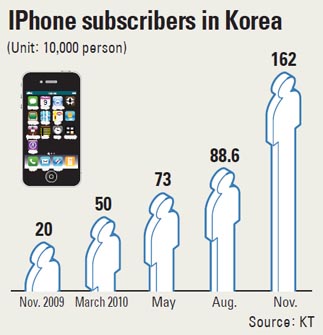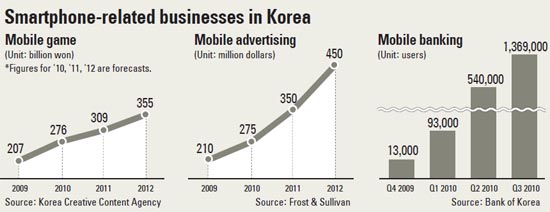In a single year, the iPhone has changed our lives

“You could say I wake up with my iPhone and go to bed with it,” he said, referring to the sleep-cycle application. “It’s helpful, but kind of fun, too.” The application works like an alarm, except that it wakes the user up at the time deemed most optimal based on its monitoring of the owner’s movements while sleeping.
Chang is also a fan of the personal trainer app - which records his running pace, distance and routes - and the calendar application.
“The iPhone has also helped with my social life,” he added. “I’m having more interactions with acquaintances than I did before through social media that the iPhone supports, sharing information and just chatting.”
Sunday marks the one-year anniversary of Apple’s iPhone debut in Korea. Prolonged regulatory bickering had been long delayed its release, coming more than a year after its release in the U.S. and other countries.
But late as it was, the iPhone’s impact was bigger than most market observers ever expected. The iPhone has influenced how people live, work, as well as socialize and entertain, as it did to Chang.

KT says high data usage is one of the most notable changes brought about by the iPhone to the telecommunications industry. An average smartphone owner uses 507 megabytes of data per month - 40 times the data used by owners of nonsmartphones.
“It’s like carrying a small computer with you always,” said Kim Na-hyun, a 29-year-old doctor, who recently bought an iPhone. “Checking your e-mail, or looking for something online, you can do it instantly - no waiting.”
An iPhone user who works at a tech company, agreed: “With the iPhone there are more ways to have fun: I watch news, listen to music and enjoy movies online with my smartphone.”
But the iPhone boom is not just a story of a single well-selling handset. The iPhone triggered the releases of many other smartphones in the market.
“Changes in the market and society can either occur from within or outside,” said Kang Jeong-su, a researcher at Yonsei University’s communications lab. “The iPhone is a humongous shock that came externally.”
After all, Korea is home to the world’s No. 2 and No. 3 cell-phone manufacturers - Samsung Electronics and LG Electronics - and the market has traditionally been dominated by domestic cell phones, which make up around 90 percent of the market share.

Samsung managed to get fairly good reviews for its smartphone, but LG’s story hasn’t been a happy one. LG ended up posting a record quarterly operating loss in the third quarter because of its late entry into the smartphone party. Nam Yong, LG Electronics’ chief executive, resigned in September to take responsibility.
“The demand for mobile phones over the past five years edged up by 1.6 times, but demand for smartphones surged five times,” said J.K. Shin, president of Samsung’s mobile division at a recent meeting. “While the mobile phone market will grow little, the smartphone market will expand explosively.”
The smartphone boom is also having a ripple effect on related businesses. Application development has emerged as a new way to make money. With more Koreans dreaming to develop a hit application, Korean-made applications on Apple’s AppStore grew from 2,367 in December 2009 to 7,475 in mid-November.
KT and other IT companies are also hosting various events to encourage more application development to get hit applications on their application stores, deeming rich applications as a key to success in the smartphone battle. After all, what’s the benefit of having a device if there’s no fun content to play with?
“New businesses merging IT with traditional industries will grow fast, like mobile banking, mobile games and mobile advertising,” KT said in a statement, citing various sources.
According to the Bank of Korea, users of mobile banking service skyrocketed to 1.4 million in the third quarter of this year from just 13,000 in the fourth quarter of 2009. Korea Creative Content Agency, a government agency, forecasts the market for mobile games will surge to 355 billion won ($310 million) in 2012 from last year’s 207 billion.
By Kim Hyung-eun [hkim@joongang.co.kr]










with the Korea JoongAng Daily
To write comments, please log in to one of the accounts.
Standards Board Policy (0/250자)